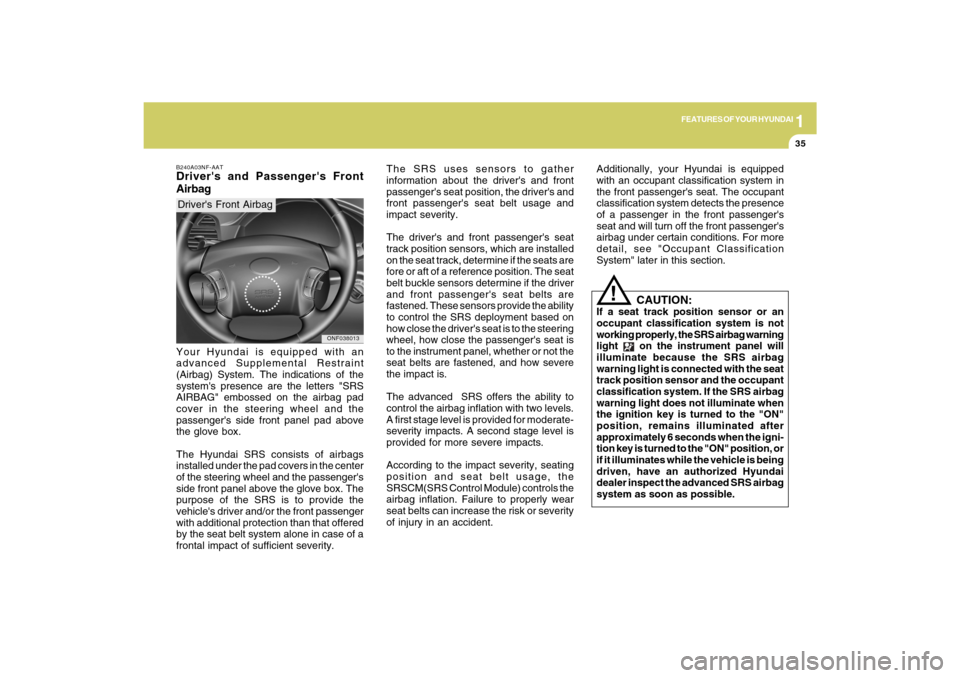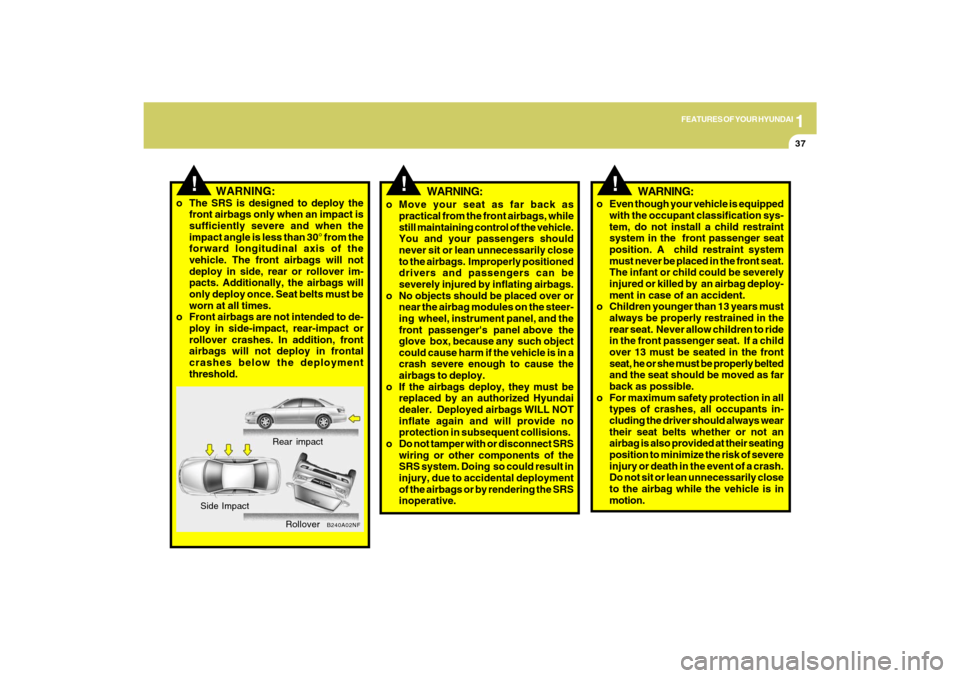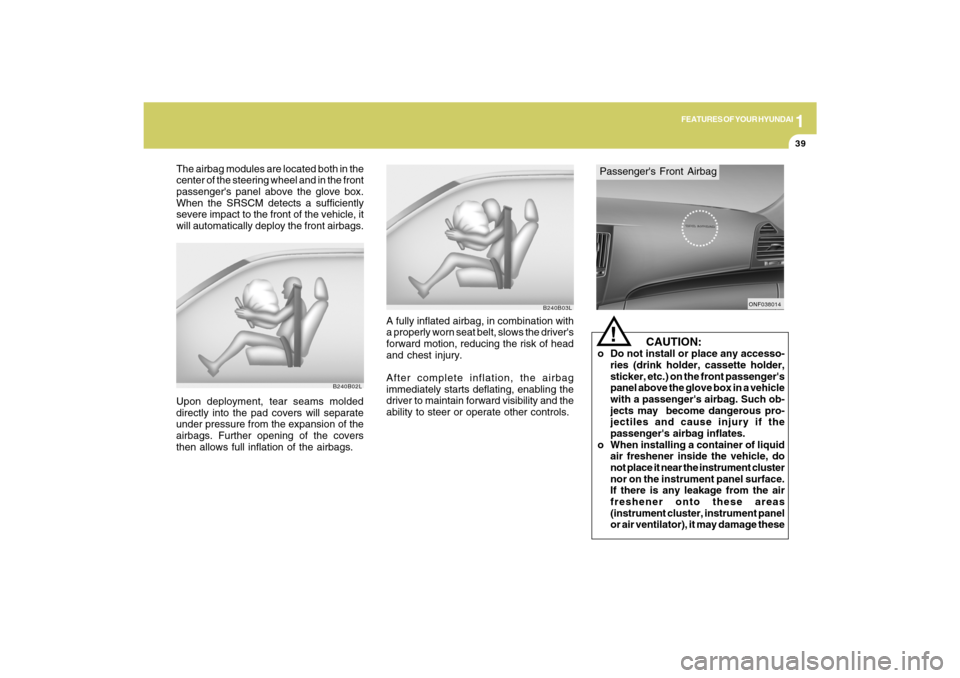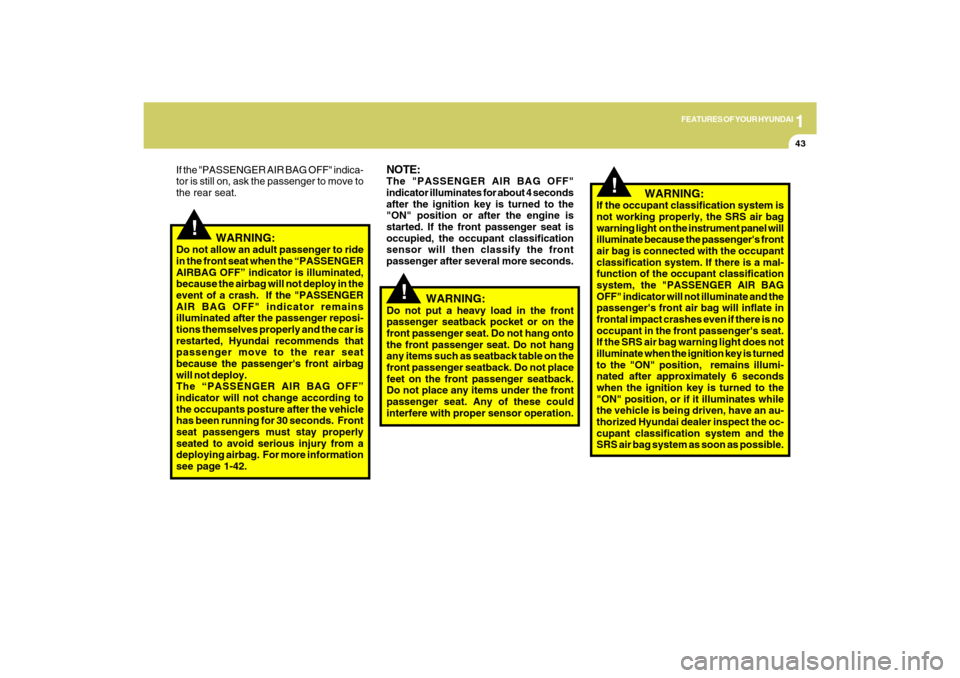2009 Hyundai Sonata instrument panel
[x] Cancel search: instrument panelPage 10 of 286

F9
1. Door lock/unlock button
2. Outside rearview mirror control switch*
3. Central door lock switch*
4. Power window lock switch*
5. Power window switches*
6. Trunk lid release lever
7. Fuel filler lid opener button
8. Panel Brightness Control Knob (Rheostat Switch)
9. Electronic Stability Control (ESC) Switch
CAUTION:
When installing a container of liquid air freshener inside the vehicle, do not place it near the instrument cluster
nor on the instrument panel surface. If there is any leakage from the air freshener onto these areas
(Instrument cluster, instrument panel or air ventilator), it may damage these parts. If the liquid from the air
freshener does leak onto these areas, wash them with water immediately.
!
10. Power Adjustable Pedals Switch*
11. Steering wheel tilt
12. Hood release lever
13. Brake pedal
14. Accelerator pedal
15. Clutch pedal*
16. Fuse box
* : if installed
Page 12 of 286

F11
1. Driver’s air bag
2. Light control / Turn signals
3. Instrument cluster
4. Wiper/Washer
5. Cruise control switch*
6. Ignition switch
7. "PASSENGER AIR BAG OFF" Indicator
8. Digital clock*
9. Audio controls*
10. Heating/Air conditioning control panel*
CAUTION:
When installing a container of liquid air freshener inside the vehicle, do not place it near the instrument cluster
nor on the instrument panel surface. If there is any leakage from the air freshener onto these areas
(Instrument cluster, instrument panel or air ventilator), it may damage these parts. If the liquid from the air
freshener does leak onto these areas, wash them with water immediately.
!
11. Hazard warning flasher switch
12. Seat warmer*
13. Shift lever
14. Cigarette lighter
15. Power outlet
16. Ashtray
17. Passenger’s air bag
18. Vent controls
19. Glove box
* : if installed
Page 30 of 286

1
FEATURES OF YOUR HYUNDAI
17
B080E01Y-AATLumbar Support Control
(Driver's Seat Only) (If Installed)To adjust the lumbar support, turn the
handle on the outboard or left side of the
seat. To increase the amount of lumbar
support, pull the lever forward. To decrease
it, push the lever toward the rear.
1. Minimum support
2. Maximum support
ONF038006
2
!
B090A02Y-AATPOWER DRIVER'S SEAT (If Installed)The driver's seat can be adjusted by using
the control knobs on the left side of the seat.
Before driving, adjust the seat to the proper
position so as to easily control the steering
wheel, pedals and switches on the
instrument panel.
CAUTION:
Do not operate two knobs at the same
time.
WARNING:
o Never adjust a driver’s seat while the
vehicle is moving. Any sudden or
unexpected movement of the seat
could cause you to lose control of the
vehicle resulting in an accident. Only
adjust the driver’s seat when the
vehicle is stationary.
o Do not sit or lean unnecessarily close
to the airbag. Position the seat so that
you can sit as far back as possible
from the airbag and still comfortably
reach all controls.
!
B080F01NF-GATSeat Height Adjustment
(Driver's Seat Only)To raise or lower the seat, raise or lower the
control lever to the desired seat height.
ONF038004
1
Page 46 of 286

1
FEATURES OF YOUR HYUNDAI
33
!
o Be sure you and your passengers
always wear seat belts and wear them
properly.NOTE:o Both the driver's and front
passenger's pre-tensioner seat belts
will be activated in certain frontal col-
lisions. The pre-tensioner seat belts
can be activated alone or, where the
frontal collision is severe enough,
together with the airbags.
The pre-tensioners will not be
activated if the seat belts are not being
worn at the time of the collision.
o When the pre-tensioner seat belts are
activated, a loud noise may be heard
and fine dust, which may appear to be
smoke, may be visible in the
passenger compartment. These are
normal operating conditions and are
not hazardous.
o Although it is harmless, the fine dust
may cause skin irritation and should
not be breathed for prolonged periods.
Wash all exposed skin areas thor-
oughly after an accident in which the
pre-tensioner seat belts were acti-
vated.
WARNING:
!
CAUTION:
o Because the sensor that activates
the SRS airbag is connected with the
pre-tensioner seat belt, the SRS airbag
warning light
on the instrument
panel will illuminate for approximately
6 seconds after the ignition key has
been turned to the "ON" position, and
then it should turn off.
o If the pre-tensioner seat belt is not
working properly, this warning light
will illuminate even if there is no
malfunction of the SRS airbag. If the
SRS airbag warning light does not
illuminate when the ignition key is
turned to "ON", or if it blinks for a
second and remains illuminated after
illuminating for approximately 6 sec-
onds, or if it illuminates while the ve-
hicle is being driven, please have an
authorized Hyundai dealer inspect the
pre-tensioner seat belt or SRS airbag
system as soon as possible.
!
WARNING:
o Pre-tensioners are designed to oper-
ate only one time. After activation,
pre-tensioner seat belts must be re-
placed. All seat belts, of any type,
should always be replaced after they
have been worn during a collision.
o The pre-tensioner seat belt assembly
mechanisms become hot during acti-
vation. Do not touch the pre-tensioner
seat belt assemblies for several min-
utes after they have been activated.
o Do not attempt to inspect or replace
the pre-tensioner seat belts yourself.
This must be done by an authorized
Hyundai dealer.
o Do not strike the pre-tensioner seat
belt assemblies.
o Do not attempt to service or repair the
pre-tensioner seat belt system in any
manner.
o Improper handling of the pre-tensioner
seat belt assemblies, and failure to
heed the warnings not to strike, modify,
inspect, replace, service or repair the
pre-tensioner seat belt assemblies
may lead to improper operation or
inadvertent activation and serious
injury.
o Always wear the seat belts when driv-
ing or riding in a motor vehicle.
Page 48 of 286

1
FEATURES OF YOUR HYUNDAI
35
The SRS uses sensors to gather
information about the driver's and front
passenger's seat position, the driver's and
front passenger's seat belt usage and
impact severity.
The driver's and front passenger's seat
track position sensors, which are installed
on the seat track, determine if the seats are
fore or aft of a reference position. The seat
belt buckle sensors determine if the driver
and front passenger's seat belts are
fastened. These sensors provide the ability
to control the SRS deployment based on
how close the driver's seat is to the steering
wheel, how close the passenger's seat is
to the instrument panel, whether or not the
seat belts are fastened, and how severe
the impact is.
The advanced SRS offers the ability to
control the airbag inflation with two levels.
A first stage level is provided for moderate-
severity impacts. A second stage level is
provided for more severe impacts.
According to the impact severity, seating
position and seat belt usage, the
SRSCM(SRS Control Module) controls the
airbag inflation. Failure to properly wear
seat belts can increase the risk or severity
of injury in an accident.
CAUTION:
If a seat track position sensor or an
occupant classification system is not
working properly, the SRS airbag warning
light
on the instrument panel will
illuminate because the SRS airbag
warning light is connected with the seat
track position sensor and the occupant
classification system. If the SRS airbag
warning light does not illuminate when
the ignition key is turned to the "ON"
position, remains illuminated after
approximately 6 seconds when the igni-
tion key is turned to the "ON" position, or
if it illuminates while the vehicle is being
driven, have an authorized Hyundai
dealer inspect the advanced SRS airbag
system as soon as possible.
!
Additionally, your Hyundai is equipped
with an occupant classification system in
the front passenger's seat. The occupant
classification system detects the presence
of a passenger in the front passenger's
seat and will turn off the front passenger's
airbag under certain conditions. For more
detail, see "Occupant Classification
System" later in this section.
B240A03NF-AATDriver's and Passenger's Front
AirbagYour Hyundai is equipped with an
advanced Supplemental Restraint
(Airbag) System. The indications of the
system's presence are the letters "SRS
AIRBAG" embossed on the airbag pad
cover in the steering wheel and the
passenger's side front panel pad above
the glove box.
The Hyundai SRS consists of airbags
installed under the pad covers in the center
of the steering wheel and the passenger's
side front panel above the glove box. The
purpose of the SRS is to provide the
vehicle's driver and/or the front passenger
with additional protection than that offered
by the seat belt system alone in case of a
frontal impact of sufficient severity.Driver's Front Airbag
ONF038013
Page 50 of 286

1
FEATURES OF YOUR HYUNDAI
37
!
WARNING:
o Move your seat as far back as
practical from the front airbags, while
still maintaining control of the vehicle.
You and your passengers should
never sit or lean unnecessarily close
to the airbags. Improperly positioned
drivers and passengers can be
severely injured by inflating airbags.
o No objects should be placed over or
near the airbag modules on the steer-
ing wheel, instrument panel, and the
front passenger's panel above the
glove box, because any such object
could cause harm if the vehicle is in a
crash severe enough to cause the
airbags to deploy.
o If the airbags deploy, they must be
replaced by an authorized Hyundai
dealer. Deployed airbags WILL NOT
inflate again and will provide no
protection in subsequent collisions.
o Do not tamper with or disconnect SRS
wiring or other components of the
SRS system. Doing so could result in
injury, due to accidental deployment
of the airbags or by rendering the SRS
inoperative.
!
WARNING:
o The SRS is designed to deploy the
front airbags only when an impact is
sufficiently severe and when the
impact angle is less than 30° from the
forward longitudinal axis of the
vehicle. The front airbags will not
deploy in side, rear or rollover im-
pacts. Additionally, the airbags will
only deploy once. Seat belts must be
worn at all times.
o Front airbags are not intended to de-
ploy in side-impact, rear-impact or
rollover crashes. In addition, front
airbags will not deploy in frontal
crashes below the deployment
threshold.
!
WARNING:
o Even though your vehicle is equipped
with the occupant classification sys-
tem, do not install a child restraint
system in the front passenger seat
position. A child restraint system
must never be placed in the front seat.
The infant or child could be severely
injured or killed by an airbag deploy-
ment in case of an accident.
o Children younger than 13 years must
always be properly restrained in the
rear seat. Never allow children to ride
in the front passenger seat. If a child
over 13 must be seated in the front
seat, he or she must be properly belted
and the seat should be moved as far
back as possible.
o For maximum safety protection in all
types of crashes, all occupants in-
cluding the driver should always wear
their seat belts whether or not an
airbag is also provided at their seating
position to minimize the risk of severe
injury or death in the event of a crash.
Do not sit or lean unnecessarily close
to the airbag while the vehicle is in
motion.
B240A02NF
Rear impact
Side Impact
Rollover
Page 52 of 286

1
FEATURES OF YOUR HYUNDAI
39
B240B02L
Upon deployment, tear seams molded
directly into the pad covers will separate
under pressure from the expansion of the
airbags. Further opening of the covers
then allows full inflation of the airbags.A fully inflated airbag, in combination with
a properly worn seat belt, slows the driver's
forward motion, reducing the risk of head
and chest injury.
After complete inflation, the airbag
immediately starts deflating, enabling the
driver to maintain forward visibility and the
ability to steer or operate other controls.
B240B03L
The airbag modules are located both in the
center of the steering wheel and in the front
passenger's panel above the glove box.
When the SRSCM detects a sufficiently
severe impact to the front of the vehicle, it
will automatically deploy the front airbags.
CAUTION:
o Do not install or place any accesso-
ries (drink holder, cassette holder,
sticker, etc.) on the front passenger's
panel above the glove box in a vehicle
with a passenger's airbag. Such ob-
jects may become dangerous pro-
jectiles and cause injury if the
passenger's airbag inflates.
o When installing a container of liquid
air freshener inside the vehicle, do
not place it near the instrument cluster
nor on the instrument panel surface.
If there is any leakage from the air
freshener onto these areas
(instrument cluster, instrument panel
or air ventilator), it may damage these
!
ONF038014
Passenger's Front Airbag
Page 56 of 286

1
FEATURES OF YOUR HYUNDAI
43
!
!
NOTE:The "PASSENGER AIR BAG OFF"
indicator illuminates for about 4 seconds
after the ignition key is turned to the
"ON" position or after the engine is
started. If the front passenger seat is
occupied, the occupant classification
sensor will then classify the front
passenger after several more seconds.
!
WARNING:
If the occupant classification system is
not working properly, the SRS air bag
warning light on the instrument panel will
illuminate because the passenger's front
air bag is connected with the occupant
classification system. If there is a mal-
function of the occupant classification
system, the "PASSENGER AIR BAG
OFF" indicator will not illuminate and the
passenger's front air bag will inflate in
frontal impact crashes even if there is no
occupant in the front passenger's seat.
If the SRS air bag warning light does not
illuminate when the ignition key is turned
to the "ON" position, remains illumi-
nated after approximately 6 seconds
when the ignition key is turned to the
"ON" position, or if it illuminates while
the vehicle is being driven, have an au-
thorized Hyundai dealer inspect the oc-
cupant classification system and the
SRS air bag system as soon as possible. If the "PASSENGER AIR BAG OFF" indica-
tor is still on, ask the passenger to move to
the rear seat.
WARNING:
Do not allow an adult passenger to ride
in the front seat when the “PASSENGER
AIRBAG OFF” indicator is illuminated,
because the airbag will not deploy in the
event of a crash. If the "PASSENGER
AIR BAG OFF" indicator remains
illuminated after the passenger reposi-
tions themselves properly and the car is
restarted, Hyundai recommends that
passenger move to the rear seat
because the passenger's front airbag
will not deploy.
The “PASSENGER AIR BAG OFF”
indicator will not change according to
the occupants posture after the vehicle
has been running for 30 seconds. Front
seat passengers must stay properly
seated to avoid serious injury from a
deploying airbag. For more information
see page 1-42.
WARNING:
Do not put a heavy load in the front
passenger seatback pocket or on the
front passenger seat. Do not hang onto
the front passenger seat. Do not hang
any items such as seatback table on the
front passenger seatback. Do not place
feet on the front passenger seatback.
Do not place any items under the front
passenger seat. Any of these could
interfere with proper sensor operation.